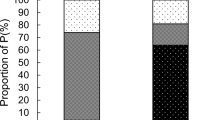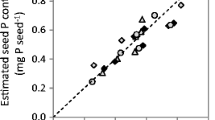Abstract
Soybean seeds with B concentrations ≤ 10 mg B kg-1 have been reported to have deformed cotyledons. This paper examines the relationship of seed B concentration to seed germination, seedling normality, and plant growth of soybean (Glycine max) cv. NW1 sown in soil with a range of B levels. Seed with 7 mg B kg-1 performed poorly, with 80% failing to germinate. Moreover, 70% of the seedlings which emerged were abnormal when sown on a low B soil. Increasing soil B had no effect on germination but decreased the percentage of abnormal seedlings by one third. Seed with 10 mg B kg-1 germinated as well as seed with 14 or 20 mg B kg-1, but when sown on a low B soil, 80% of the seedlings were abnormal compared with 50 and 20%, respectively. Increasing soil B almost eliminated the incidence of seedling abnormality when seed contained 10 – 20 mg B kg-1. When grown to maturity on the lowest soil B, plants from seed with 10 mg B kg-1 produced less than half the seed yield of plants from seed with 14 or 20 mg B kg-1. They had fewer pods per plant and fewer seeds per pod. They responded strongly to increasing soil B, so that in soil with higher B levels, plants from seed with 10, 14 or 20 mg B kg-1 gave the same yield.
The results suggested that soybean seed with a low concentration of B have permanently damaged seed embryos, preventing their germination or producing defective seedlings. At slightly higher concentrations, embryos are not permanently damaged, but require a higher level of external B for their normal development than do those with higher concentrations of seed B. In the present experiments, the critical concentration of B in soybean seed for permanent damage was between 7 and 10 mg B kg-1, and for normal seedling development in low B soils was between 14 and 20.
Similar content being viewed by others
References
Bell RW, McLay LD, Plaskett D, Dell B & Loneragan JF (1989) Germination and vigour of black gram (Vigna mungo L. Hepper) seed from plants grown with and without boron. Aust J Agric Res 40: 273–279
Bergmann W (Ed.) (1992) Nutritional Disorders of Plants. Colour Atlas. Stuttgart: Gustav Fischer Verlag Jena.
Dible WT & Berger KC (1952) Boron content of alfalfa as influenced by boron supply. Soil Sci Soc Amer Proc 16: 60–62
Fehr WR, Caviness CE, Burwood DT & Pennington JS (1971) Stage of development descriptions for soybeans, Glycine max (L.) Merrill. Crop Sci 11: 929–931
Gupta UC (1993) Responses to boron in field and horticultural crop yields. In: Gupta UC (ed) Boron and its Role in Crop Production, pp 177–183. Boca Raton, Florida: CRC Press
Kaosa-ard M, Shinawatra B, Rerkasem B, Rerkasem K & Isarangkura A (1987) Agronomic and financial aspects of the inclusion of oilseed crops at farm level in Thailand, Chulalongkorn University and Chiang Mai University: Socioeconomic Policy and Forecasting Unit.
Kirk G & Loneragan JF (1988) Functional boron requirements for leaf expansion and its use as a critical value for diagnosis of boron deficiency in soybean (Glycine max L. Merr.) cv. Buchanan. Agron J 80: 758–762
Lohse G (1982) Microanalytical azomethine-H method for boron determination in plant tissue. Comm Soil Sci Plant Anal 13: 127–134
Predisripipat S (1988) Responses to boron application in Vigna. M Sc (Agric) thesis, Chiang Mai, Thailand: Chiang Mai University
Rerkasem B, Bell RW & Loneragan JF (1989) Effects of seed and soil boron on early seedling growth of black and green gram (Vigna munga and V. radiata). In: van Beusichem ML (ed) Plant Nutrition-Physiology and Applications, pp. 281–285. Dordrecht, The Netherlands: Kluwer Academic Publishers.
Rerkasem B, Netsangtip R, Bell RW, Loneragan JF & Hirunburana N (1988) Comparative species responses to boron on a Typic Tropaqualf in Northern Thailand. Plant Soil 106: 15–21
Rerkasem B, Bell RW, Loedkaew S & Loneragan JF (1993) Boron deficiency in soybean [Glycine max (L.) Merr.], peanut (Arachis hypogaea L.) and black gram [Vigna mungo (L.) Hepper]: symptoms in seeds and differences among soybean cultivars in susceptibility to boron deficiency. Plant Soil 150: 289–294
Saarela I (1985) Plant available boron in soils and boron requirements of spring oilseed rapes. Annales Agriculturae Fenniae 24: 183–265
Shorrocks VM (1992) Boron-a global appraisal of the occurrence, diagnosis and correction of boron deficiency. In: Portch S (ed) Proc. Int. Symposium on the Role of Sulphur Magnesium and Micronutrients in Balanced Plant Nutrition, pp 39–53. Hong Kong: Potash and Phosphate Institute.
Sillapaa M (1982) Micronutrients and the Nutrient Status of Soils: A Global Study. FAO Soils Bulletin 48. Rome: FAO
Sillapaa M (1990) Micronutrient Assesment at the Country Level: An International Study. FAO Soils Bulletin 63. Rome: FAO
Snedecor GW & Cochran WG (1968) Statistical Methods. 6th Edition. Ames, Iowa, USA: The Iowa Sate University Press
Author information
Authors and Affiliations
Rights and permissions
About this article
Cite this article
Rerkasem, B., Bell, R., Lodkaew, S. et al. Relationship of seed boron concentration to germination and growth of soybean (t Glycine max). Nutrient Cycling in Agroecosystems 48, 217–223 (1997). https://doi.org/10.1023/A:1009725311624
Issue Date:
DOI: https://doi.org/10.1023/A:1009725311624




